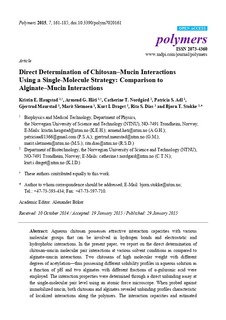| dc.contributor.author | Haugstad, Kristin Elisabeth | |
| dc.contributor.author | Håti, Armend Gazmeno | |
| dc.contributor.author | Nordgård, Catherine Taylor | |
| dc.contributor.author | Adl, Patricia S. | |
| dc.contributor.author | Maurstad, Gjertrud | |
| dc.contributor.author | Sletmoen, Marit | |
| dc.contributor.author | Draget, Kurt Ingar | |
| dc.contributor.author | Dias, Rita de Sousa | |
| dc.contributor.author | Stokke, Bjørn Torger | |
| dc.date.accessioned | 2019-11-08T09:29:23Z | |
| dc.date.available | 2019-11-08T09:29:23Z | |
| dc.date.created | 2015-02-02T10:17:54Z | |
| dc.date.issued | 2015 | |
| dc.identifier.citation | Polymers. 2015, 7 (2), 161-185. | nb_NO |
| dc.identifier.issn | 2073-4360 | |
| dc.identifier.uri | http://hdl.handle.net/11250/2627352 | |
| dc.description.abstract | Aqueous chitosan possesses attractive interaction capacities with various molecular groups that can be involved in hydrogen bonds and electrostatic and hydrophobic interactions. In the present paper, we report on the direct determination of chitosan–mucin molecular pair interactions at various solvent conditions as compared to alginate–mucin interactions. Two chitosans of high molecular weight with different degrees of acetylation—thus possessing different solubility profiles in aqueous solution as a function of pH and two alginates with different fractions of α-guluronic acid were employed. The interaction properties were determined through a direct unbinding assay at the single-molecular pair level using an atomic force microscope. When probed against immobilized mucin, both chitosans and alginates revealed unbinding profiles characteristic of localized interactions along the polymers. The interaction capacities and estimated parameters of the energy landscapes of the pairwise chitosan–mucin and alginate–mucin interactions are discussed in view of possible contributions from various fundamental forces. Signatures arising both from an electrostatic mechanism and hydrophobic interaction are identified in the chitosan–mucin interaction properties. The molecular nature of the observed chitosan–mucin and alginate–mucin interactions indicates that force spectroscopy provides fundamental insights that can be useful in understanding the surface binding properties of other potentially mucoadhesive polymers. | nb_NO |
| dc.language.iso | eng | nb_NO |
| dc.publisher | MDPI | nb_NO |
| dc.rights | Navngivelse 4.0 Internasjonal | * |
| dc.rights.uri | http://creativecommons.org/licenses/by/4.0/deed.no | * |
| dc.title | Direct Determination of Chitosan–Mucin Interactions Using a Single-Molecule Strategy: Comparison to Alginate–Mucin Interactions | nb_NO |
| dc.type | Journal article | nb_NO |
| dc.type | Peer reviewed | nb_NO |
| dc.description.version | publishedVersion | nb_NO |
| dc.source.pagenumber | 161-185 | nb_NO |
| dc.source.volume | 7 | nb_NO |
| dc.source.journal | Polymers | nb_NO |
| dc.source.issue | 2 | nb_NO |
| dc.identifier.doi | 10.3390/polym7020161 | |
| dc.identifier.cristin | 1215172 | |
| dc.description.localcode | © 2015 by the authors; licensee MDPI, Basel, Switzerland. This article is an open access article distributed under the terms and conditions of the Creative Commons Attribution license (http://creativecommons.org/licenses/by/4.0/). | nb_NO |
| cristin.unitcode | 194,66,20,0 | |
| cristin.unitcode | 194,66,15,0 | |
| cristin.unitname | Institutt for fysikk | |
| cristin.unitname | Institutt for bioteknologi og matvitenskap | |
| cristin.ispublished | true | |
| cristin.fulltext | original | |
| cristin.qualitycode | 1 | |

